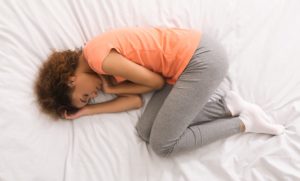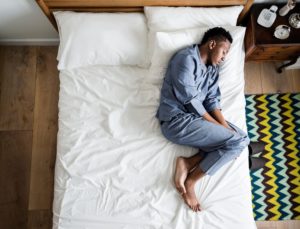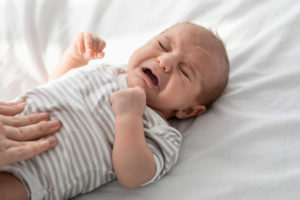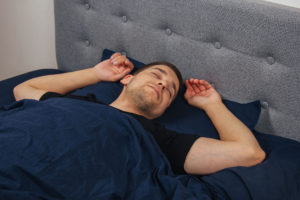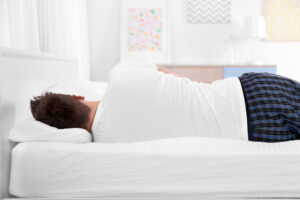When you buy through our links, we may earn a commission. Products or services may be offered by an affiliated entity. Learn more.
What Side Should You Sleep on if You Have a Ruptured Eardrum?
A ruptured eardrum is a hole or tear in the thin membrane inside the ear that helps with hearing. The eardrum can be damaged by ear infections, sudden changes in pressure, or injuries from inserting items into the ear. Ruptured eardrums can be painful and interfere with sleep. For this reason, some people with ruptured eardrums may wonder which side they should sleep on.
There isn’t a universal solution for how to sleep with a ruptured eardrum. However, if the eardrums hurt, sleeping in a new position may be more comfortable. We discuss common symptoms and causes of ruptured eardrums and ways that people can take care of their ears and reduce discomfort. We also discuss when to seek medical care for a ruptured eardrum and what to expect for treatment and follow-up.
How to Sleep With a Ruptured Eardrum
People may have difficulty sleeping when one or both ears hurt. Therefore, people with ear pain after a ruptured eardrum should talk to their doctors about pain relief to help them sleep comfortably. In addition, temporary adjustments to sleeping positions may help reduce discomfort from sleeping on a ruptured eardrum.
Depending on the cause, people may have ruptured eardrums in one or both ears. If only one eardrum is ruptured, then they may feel more comfortable sleeping on their back or on the side of the opposite ear, with the ruptured ear facing up. Side sleeping in this way may also help ear drops to absorb, if they are prescribed or recommended by a doctor.
If both eardrums are ruptured, then back sleeping may be the most comfortable position until the ears heal. People who feel a lot of pressure in their ears might also consider sleeping upright or on multiple pillows. One small study found that people with chronically ruptured eardrums had higher pressures in their middle ears when lying down compared to when upright.
Symptoms of a Ruptured Eardrum
Some people may not experience any symptoms during or after a ruptured eardrum. However, common symptoms of a ruptured eardrum may include:
- Intense, sharp ear pain
- Clear, bloody, or yellowish fluid that drains from the ear
- Partial hearing loss in the injured ear
- Ringing in the injured ear
Some people may feel a spinning sensation after a ruptured eardrum. If it occurs, the spinning sensation usually lasts for a very short time. However, if the spinning sensation does not improve quickly then this may mean that the inner ear is damaged.
Problems in the eardrum or middle ear may cause a form of hearing loss that stops or limits sounds from reaching the inner ear. This happens because the eardrum vibrates when it is hit by sound waves entering the ear. These vibrations move tiny bones in the middle ear, which amplify the sounds and send them on to the inner ear.
Causes of a Ruptured Eardrum
The most common causes of a ruptured eardrum are infections, sudden changes in pressure, and injuries.
Middle ear infection is the most common cause of ruptured eardrums, particularly in children. During a middle ear infection, the middle ear fills with fluid and pus . The resulting high pressure may tear a hole in the eardrum and cause drainage from the ear. People with middle ear infections may feel pain and pressure in one or both ears that is rapidly relieved when the eardrum ruptures.
Sudden changes in pressure can also cause the eardrum to rupture. Ordinarily, the air pressure inside the middle ear is equal to the pressure outside the ear. However, if the system that balances pressure within the ear does not work as it should, then large pressure differences on either side of the eardrum can damage or tear it. This may happen with rapid pressure changes during scuba diving, air travel, or when traveling to high altitude environments.
Ear trauma is another common cause of ruptured eardrums. Both children and adults may accidentally pierce their eardrums with cotton swabs or other ear cleaning devices. In addition, head injuries that compress the ear or break bones in the base of the skull may also rupture one or both eardrums.
Other potential causes of ruptured eardrums include:
- Very loud and sudden noises
- Strong suction on the ear
- Shock waves from explosions
- Lightning strikes
People who have previously had ear surgery or repeated middle ear infections are at higher risk of ruptured eardrums. Indigenous children, people with limited access to health care, and people infected with group A Streptococcus bacteria are also at higher risk of ruptured eardrums from middle ear infections.
Home Care for a Ruptured Eardrum
Anyone who thinks that they may have a ruptured eardrum should talk to their doctor. A doctor can look inside the ear to diagnose a ruptured eardrum. They may also order a test to check for hearing loss. A doctor can also provide instructions to protect the eardrum, prescribe antibiotics, and schedule a follow-up appointment to check whether their ear is healing.
Most ruptured eardrums will heal on their own without treatment. People with ruptured eardrums should follow their doctor’s advice. In addition, there are several steps that they can take at home.
Protect the Affected Ear
People with ruptured eardrums should take care to keep water out of their ears until the tear heals. If water gets into the ear, it could cause a middle ear infection. This is because water in the ears could carry germs through a tear in the eardrum and into the middle ear.
If possible, people with ruptured eardrums should avoid putting their heads under water. If they can not entirely avoid water, then they should consider gently placing cotton balls in their external ears while in the shower or washing their hair and using earplugs while swimming.
Apply a Warm Compress
A warm compress on the affected ear may help to reduce pain from a ruptured eardrum. To prepare a warm compress, run a soft washcloth under warm water and then hold it to the ear for several minutes. Make sure that water does not enter the ear and that the compress is at a comfortable temperature before placing it against the skin.
Try Over-the-Counter Pain Medicine
People who have ongoing pain after a ruptured eardrum may consider using over-the-counter pain medicine such as acetaminophen or ibuprofen. People should talk to their doctors if their ear pain is not relieved by over-the-counter pain medicine.
Do Not Insert Items in the Ear Canal
People should never insert items into their ears, whether they are ruptured or not. Cotton-tipped swabs and other items can damage or pierce the eardrums. One large study of people with ruptured eardrums found that over one-quarter were caused by cotton-tipped swabs. If an item does become stuck in the ear, people should not attempt to remove it themselves and should seek medical care.
If blood or other fluid drains from the ear, people may gently wipe the outside of the ear but should not attempt to clean the ear canal without medical attention.
Finally, people with ruptured eardrums should not take over-the-counter or herbal ear drops unless a physician has advised them to do so.
Avoid Air Travel Until Healed
Sudden changes in air pressure, such as during airplane liftoff and landing or during scuba diving, can damage the eardrum. People with ruptured eardrums should talk to their doctors before traveling by airplane or scuba diving.
When to See a Doctor
People who think they may have a ruptured eardrum should see a doctor to determine whether they have any other injuries or infection. If their pain quickly improves and they are not bothered by other symptoms, then they can wait until the next day to see a doctor.
People who think they have a ruptured eardrum should see a doctor right away if they:
- Have a head or neck injury
- Feel very dizzy
- Have significant hearing loss, such as difficulty hearing other people speak
- Have a fever
- Vomit or feel nauseated
- Have an object stuck in their ear
Most ruptured eardrums will heal on their own within a few weeks. However, some people with head or neck injuries, damage to the tiny bones in the middle ear, or with large tears in their eardrums may need surgery to repair their injuries.
A doctor treating a person with a ruptured eardrum may ask to follow up in a few weeks to check whether the eardrum has healed and whether hearing has improved. The doctor may recommend evaluation by a specialist or, if complications happen, surgery.
After a ruptured eardrum, people are at higher risk of developing chronic middle ear infections. These ear infections often do not hurt nor cause a fever. The most common symptoms are pus-like, foul smelling ear discharge, or worsening hearing loss. People should tell their doctors if they develop these symptoms after a ruptured eardrum. Chronic middle ear infections can spread to other parts of the head and cause complications.

Still have questions? Ask our community!
Join our Sleep Care Community — a trusted hub of sleep health professionals, product specialists, and people just like you. Whether you need expert sleep advice for your insomnia or you’re searching for the perfect mattress, we’ve got you covered. Get personalized guidance from the experts who know sleep best.
References
12 Sources
-
Brattmo, M., Tideholm, B., & Carlborg, B. (2003). Chronic tympanic membrane perforation: Middle ear pressure and tubal function. Acta Oto-laryngologica, 123(5), 569–574.
https://pubmed.ncbi.nlm.nih.gov/12875577/ -
Miyamoto, R. T. (2022, March). Traumatic perforation of the tympanic membrane. Merck Manual Professional Version., Retrieved December 1, 2022, from
https://www.merckmanuals.com/professional/ear,-nose,-and-throat-disorders/middle-ear-and-tympanic-membrane-disorders/traumatic-perforation-of-the-tympanic-membrane -
Evans, A. K. (2021, October 26). Evaluation and management of middle ear trauma. In R. G. Bachur & M. E. Moreira (Eds.). UpToDate., Retrieved December 1, 2022, from
https://www.uptodate.com/contents/evaluation-and-management-of-middle-ear-trauma -
Dolhi, N. & Weimer, A. D. (2022, August 8). Tympanic membrane perforations. In StatPearls. StatPearls Publishing., Retrieved December 1, 2022, from
https://www.ncbi.nlm.nih.gov/books/NBK557887/ -
Lustig, L. R. (2022, June). Hearing loss. Merck Manual Consumer Version., Retrieved December 1, 2022, from
https://www.merckmanuals.com/home/ear,-nose,-and-throat-disorders/hearing-loss-and-deafness/hearing-loss -
Pelton, S. I. & Tähtinen, P. (2022, May 18). Acute otitis media in children: Epidemiology, microbiology, and complications. In S. L. Kaplan & G. C. Isaacson (Eds.). UpToDate., Retrieved December 1, 2022, from
https://www.uptodate.com/contents/acute-otitis-media-in-children-epidemiology-microbiology-and-complications -
Miyamoto, R. T. (2022, March). Barotrauma of the ear. Merck Manual Professional Version., Retrieved December 1, 2022, from
https://www.merckmanuals.com/home/ear,-nose,-and-throat-disorders/middle-ear-disorders/barotrauma-of-the-ear -
Weber, P. C. (2022, March 15). Etiology of hearing loss in adults. In D. G. Deschler (Ed.). UpToDate., Retrieved December 1, 2022, from
https://www.uptodate.com/contents/etiology-of-hearing-loss-in-adults -
Jorolemon, M. R., Lopez, R. A, & Krywko, D. M. (2022, July 18). Blast injuries. In StatPearls. StatPearls Publishing., Retrieved December 1, 2022, from
https://www.ncbi.nlm.nih.gov/books/NBK430914/ -
Saadi, R. A. & Isildak, H. (2022, April 13). Middle ear, tympanic membrane, perforations. Medscape., Retrieved December 1, 2022, from
https://emedicine.medscape.com/article/858684-overview#showall -
Carniol, E. T., Bresler, A., Shaigany, K., Svider, P., Baredes, S., Eloy, J. A., & Ying, Y. M. (2018). Traumatic tympanic membrane perforations diagnosed in emergency departments. JAMA Otolaryngology– Head & Neck Surgery, 144(2), 136–139.
https://pubmed.ncbi.nlm.nih.gov/29270620/ -
Lustig, L. R. & Limb, C. J. (2021, January 15). Chronic otitis media, cholesteatoma, and mastoiditis in adults. In D. G. Deschler (Ed.). UpToDate., Retrieved December 4, 2022, from
https://www.uptodate.com/contents/chronic-otitis-media-cholesteatoma-and-mastoiditis-in-adults






